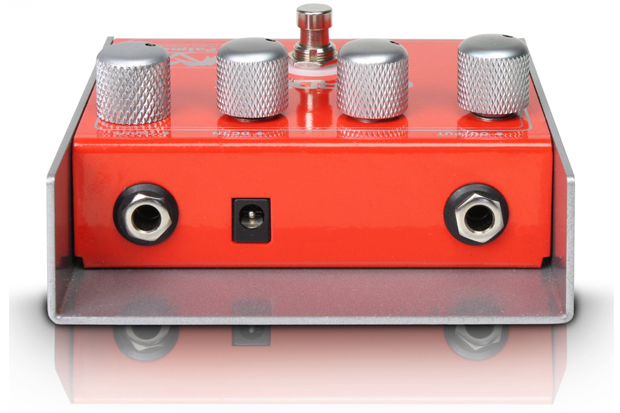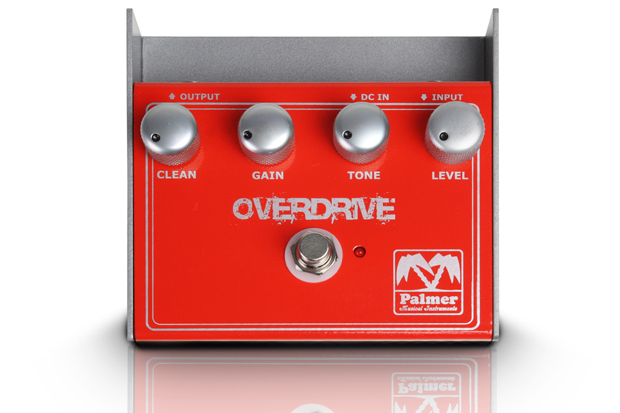Palmer Overdrive – The Red Distortion Pedal from the Taunus – Test Report by bonedo.de
The number two in Palmer’s Root Effects series, which is making its debut here in our bonedo test lab, goes simply by the name “Overdrive”. If you were expecting another pedal based more or less on the original versions of the Tubescreamer or Boss Overdrive, guess again. Palmer wouldn’t be Palmer if this pedal didn’t also include some useful and unusual feature that sets it apart from the other distortion pedals.
Housing/Look
All Palmer Root Effects come in a uniform housing measuring 120 x 95 x 56 mm with an identical design. The housing consists of two nestled, U-shaped 2 mm sheet steel sections that vary only in colour. As a rule, for most of the units in the series, this applies only for the upper part of the housing. The base remains metallic grey. In any case, our Overdrive is painted bright red.
The entire underside of the pedal is covered with thick rubber, ensuring that it stays put on all types of surfaces. This is also where the flip-out battery compartment is located. It ensures quick and simple battery replacement. The 9V block battery is simply inserted in the compartment and is pressed against the contacts automatically when the compartment is closed. No need to press on tiny contact surfaces or tease the battery out of a narrow compartment at the risk of breaking your painstakingly cultivated finger nails in fractions of a second. This is evidence of experience gained in the pro audio sector and the workaday life of a guitarist. However, the underside offers another practical feature, namely, two holes with which the pedal can be fastened to the effects board using screws.
Another practical design feature is the protruding base. Together with the protruding sides, it protects the connectors on the rear panel against external influences. This is a good defence against cables getting unplugged because an inattentive stage hand or an ecstatic singer steps exactly on the edge of the effect pedal. There is on disadvantage to this, however. This makes it impossible to use cables with right-angle plugs unless they are left pointing upward, which is not so good when using the effect on a pedal board.
The controls on the top are arranged in a row and have metal knobs that are painted grey. A recessed dot indicates the current position of the knobs, which turn rather stiffly in comparison to guitar knobs. That also makes sense, then after all, they shouldn’t change position at the slightest touch. Below the knobs is the footswitch, which works without clicking noises. The effect status is indicated by a small red LED next to the switch, which lights up when the effect is on. The bottom line is that the pedal leaves one with an impression of high quality and absolute roadworthiness. 
Rear Panel/Connections
The rear panel holds a total of three sockets, two TRS sockets for input and output and a standard connector for the DC power supply. As is usually the case with small pedals, the power supply is not included. Here you can use a standard adapter or one of the usual suspects by Boss or Ibanez. With a power consumption of approx. 15 mA, the Overdrive hovers in the middle of the range for distortion pedals. So it is possible to get through the odd gig on battery power without having to worry about the pedal giving out before you are through.
Operation
The overdrive effect is controlled by four knobs. The first of these, labelled “Clean”, is likely to cause some initial consternation among guitarists. What is that doing there? A Clean control on an overdrive pedal?
And that is precisely what makes this pedal special. The principle is simple and logical. The Clean knob adds clean signal to the overdrive sound. The result, depending on the mixing ratio, is clear attack with a dirty distortion aftertaste. Many guitarists produce this tone by combining a clean amp with one set to distort. David Gilmour (Pink Floyd) or Stevie Ray Vaughan, for example, always use or used multiple amps onstage for this purpose. In the praxis test, we will hear whether you can actually get sounds of this type out of this pedal.
Of course, there are also the controls that one expects to find on an overdrive pedal, namely, Gain to set the level of distortion, Tone for regulating the tone, and Volume for adjusting the ultimate volume of the distortion sound.
Praxis
To begin with, I will take a closer look at the overdrive section by itself. That means that the Clean knob is turned all the way to the left and is off, so it doesn’t have any effect on the sound. In our first audio sample, I have set all of the knobs (except for the Clean knob) to the middle position (12 o’clock), and this is the result:
http://www.bonedo.de/artikel/einzelansicht/palmer-overdrive/3.html
Well done! The Palmer Overdrive has an impressively warm and natural basic sound. The level of distortion ranges from discretely overdriven to mid-gain sounds that are more suitable for rhythm work than for soaring solo passages. The pedal comes with a very good basic sound that can be fine-tuned with the other settings and thus adapted to the connected equipment (guitar, amp). This means that you practically always obtain a useable sound. If you are looking for a cornucopia of sound variations and frequency bending options, you’re in the wrong place. The ability to blend the clean guitar signal with the overdrive sound opens up additional perspectives. The added clean sound ensures a clear, fat attack, while the overdrive adds the right amount of grittiness. What many guitarists use two amps for also works only with this pedal. If you need assertive overdrive sounds, you should definitely give the Palmer Overdrive a try. I nearly forgot: of course, the pedal is absolutely rugged and roadworthy in construction and represents outstanding value for money.
Palmer Overdrive
Pro
Warm, natural overdrive sound Rugged construction, absolutely roadworthy 5-year manufacturer’s guarantee Clean sound can be added to the overdrive
Contra
–
Facts
Manufacturer: Palmer
Model: Overdrive
Type: overdrive pedal
Controls: Clean, Gain, Tone Level
Connections: Input, output, 9V DC approx. 15 mA
Dimensions: 120 x 95 x 56 mm (W x D x H)
Price: EUR 80.00 (RRP)
Complete product information is available here:
http://www.palmer-germany.com/mi/en/OVERDRIVE-Distortion-effect-for-guitar-PEOD.htm
Source: www.bonedo.de, Germany
Author: Thomas Dill
Leave a Comment
You must be logged in to post a comment.











